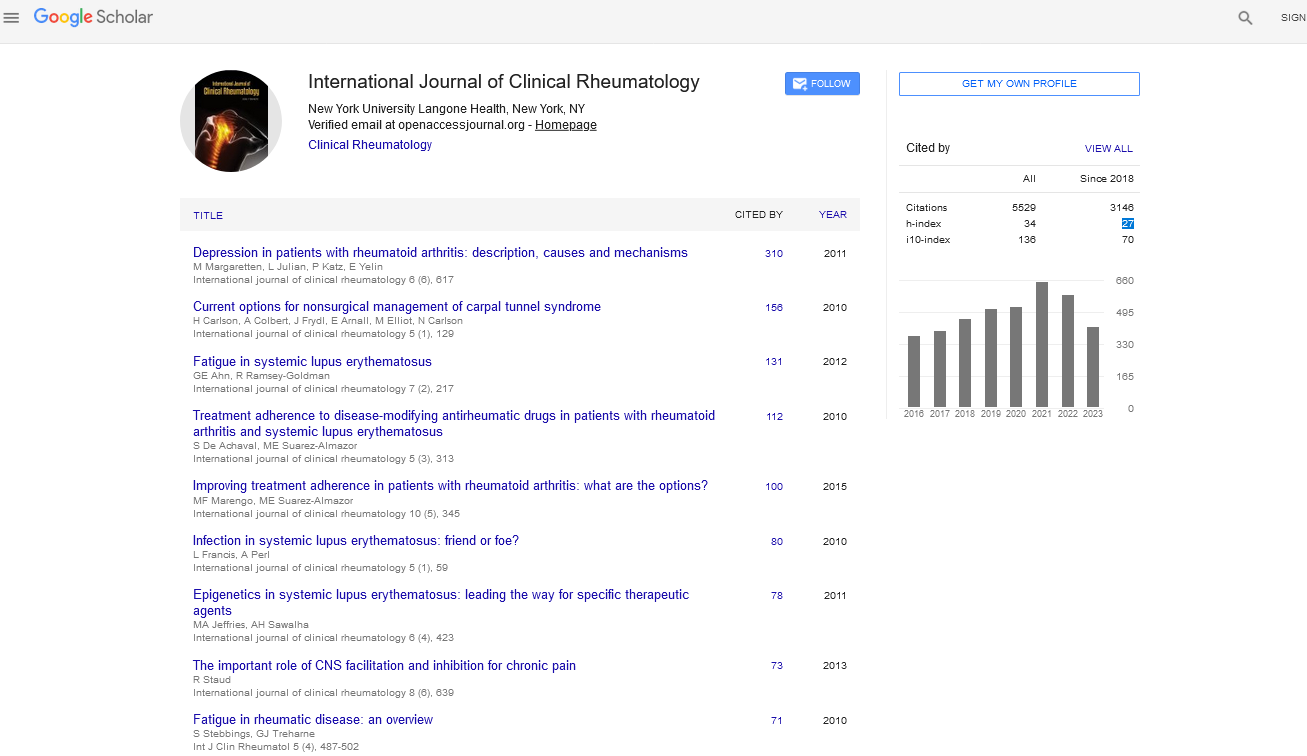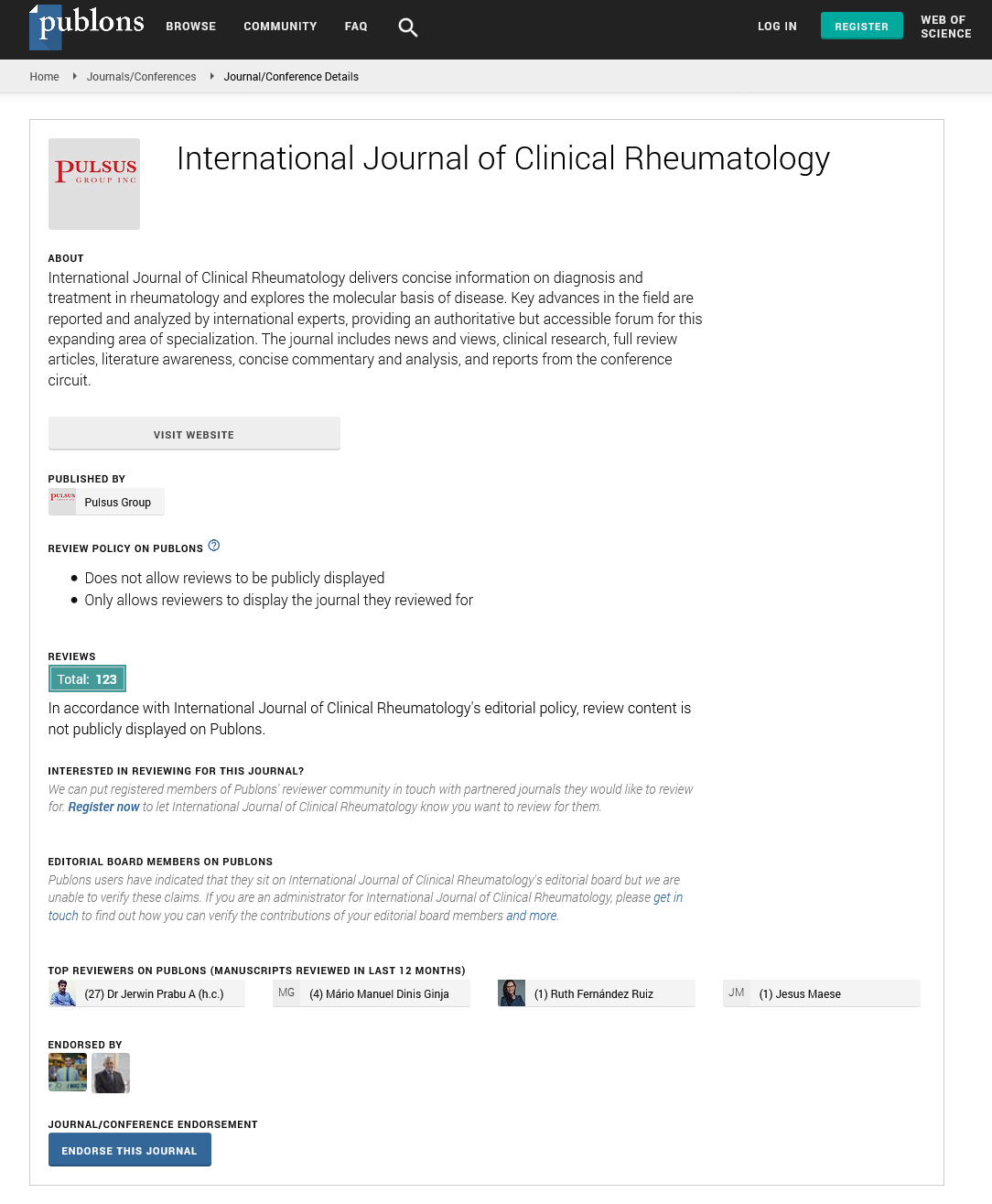Editorial - International Journal of Clinical Rheumatology (2024) Volume 19, Issue 11
Advances in the Diagnosis and Management of Systemic Lupus Erythematosus: A Review of Recent Clinical Guidelines
Noah King *
Department of Internal Medicine, Faculty of Medicine, University of Indonesia, Jakarta, Indonesia
- *Corresponding Author:
- Noah King
Department of Internal Medicine, Faculty of Medicine, University of Indonesia, Jakarta, Indonesia
E-mail: emma.scott54@live.com
Received: 02-Nov-2024, Manuscript No. fmijcr-25-157431; Editor ssigned: 04-Nov-2024, Pre-QC No. fmijcr-25-157431 (PQ); Reviewed: 18-Nov-2024, QC No. fmijcr-25-157431; Revised: 23- Nov-2024, Manuscript No. fmijcr-25-157431 (R); Published: 30- Nov-2024, DOI: 10.37532/1758-4272.2024.19(9). 313-315
Abstract
Systemic lupus erythematosus (SLE) is a multifaceted autoimmune disorder with a highly variable clinical presentation, posing challenges in diagnosis and management. This review evaluates the most recent clinical guidelines for SLE, focusing on advances in diagnostic criteria, biomarker identification, and personalized treatment approaches. Key innovations include the use of novel serological markers and imaging techniques for early diagnosis, as well as targeted biologic therapies aimed at modulating the immune system. The review also discusses the growing role of precision medicine in SLE, emphasizing individualized treatment regimens and the importance of managing comorbidities to improve patient outcomes.
Keywords
Systemic lupus erythematosusâ Diagnosisâ Clinical guidelinesâ Biomarkersâ Immunotherapyâ Precision medicineâ Autoimmune diseases
Introduction
Systemic Lupus Erythematosus (SLE) is a complex, chronic autoimmune disorder that affects multiple organ systems, including the skin, kidneys, joints, and cardiovascular system. Characterized by periods of remission and flare-ups, SLE presents significant diagnostic and therapeutic challenges due to its heterogeneous nature and variable clinical manifestations. In recent years, significant advances have been made in the diagnosis and management of SLE, driven by improvements in laboratory techniques, imaging, and therapeutic options. These advances have been reflected in updated clinical guidelines that aim to provide comprehensive and personalized care for patients. This review explores recent clinical guidelines regarding the diagnosis and management of SLE, examining key updates in diagnostic criteria, treatment strategies, and the role of emerging therapies. The review highlights the evolving landscape of SLE care, focusing on the integration of new technologies and the increasing emphasis on personalized medicine [1-3].
Discussion
Advances in diagnosis and classification criteria: The diagnostic landscape for SLE has been refined with the incorporation of more specific biomarkers and updated classification criteria. The 2019 update of the American College of Rheumatology (ACR)/European League Against Rheumatism (EULAR) classification criteria for SLE introduced a more inclusive approach, enabling earlier and more accurate identification of SLE in patients with diverse presentations. New biomarkers such as anti-dsDNA, anti-Smith antibodies, and complement levels have been integrated into clinical practice, allowing for more sensitive and specific diagnosis. These biomarkers help distinguish SLE from other autoimmune diseases with overlapping features. Advanced imaging techniques, such as ultrasound and MRI, have also contributed to better monitoring of organ involvement, particularly renal and musculoskeletal manifestations, improving early detection and management [4].
Evolving treatment approaches: Advances in treatment strategies have focused on controlling disease activity and preventing damage through immunosuppressive therapy, including corticosteroids, antimalarials, and newer biologic agents. The introduction of biologics, such as belimumab (a B-cell inhibitor) and anifrolumab (a type I interferon receptor antagonist), has revolutionized the treatment of SLE, offering targeted therapies that address the underlying pathophysiology. The concept of "treat-to-target" has been incorporated into recent clinical guidelines, emphasizing the importance of controlling disease activity and achieving remission or low disease activity. This approach uses regular monitoring of disease biomarkers and clinical signs to adjust treatment regimens accordingly. The guidelines now stress the importance of individualized treatment plans that consider the patient's specific clinical manifestations, comorbidities, and preferences. This personalized approach is key to minimizing adverse effects and improving patient outcomes [5].
Management of specific organ involvement: SLE often involves multiple organs, requiring a multidisciplinary approach to management. Recent guidelines have emphasized the need for specific management strategies for common organ manifestations, such as lupus nephritis, cutaneous lupus, and neuropsychiatric lupus. For lupus nephritis, the use of immunosuppressive therapies, such as mycophenolate mofetil and cyclophosphamide, in combination with corticosteroids, remains a cornerstone of treatment. Recent guidelines also recommend the use of novel agents, including voclosporin, which has shown promise in treating lupus nephritis with improved renal outcomes. Neuropsychiatric lupus remains a difficult area, with treatment strategies evolving to include neuroimmunological therapies and better diagnostic techniques for assessing brain involvement.
Addressing comorbidities and long-term management: Long-term management of SLE requires careful monitoring for comorbid conditions, such as cardiovascular disease, osteoporosis, and infections, which are more prevalent in SLE patients due to both the disease itself and the immunosuppressive treatments. Recent guidelines emphasize the need for proactive screening and management of these comorbidities to improve overall health outcomes. Vaccination, preventive care, and lifestyle modifications (e.g., smoking cessation and diet) have been integrated into management guidelines to reduce the burden of comorbidities and improve long-term survival. Patient education and support for self-management have been recognized as essential components of care, helping patients manage the chronic and relapsing nature of the disease effectively [6].
Conclusion
The diagnosis and management of Systemic Lupus Erythematosus have significantly advanced in recent years, driven by improvements in diagnostic criteria, the development of targeted biologic therapies, and a deeper understanding of the disease's pathophysiology. The recent updates to clinical guidelines reflect a shift toward a more personalized, patient-centered approach, with a focus on early diagnosis, individualized treatment regimens, and comprehensive management of comorbidities. While new therapies have shown promise in improving disease control and patient quality of life, challenges remain, particularly in managing organ-specific complications and long-term outcomes. As research continues, further advancements in both diagnostic and therapeutic strategies will likely improve the prognosis for SLE patients, with the potential for more effective and personalized care in the future.
References
- Rodrigues CD, Carlos E. Traumatic Bone Cyst Suggestive of Large Apical Periodontitis. J Endod. 34(4), 484-489 (2008).
- Kayani B, Sharma A, Sewell MD, et al. A Review of the Surgical Management of Extrathoracic Solitary Fibrous Tumors. Am J Clin Oncol. 41(7), 687-694 (2018).
- Choi H, Charnsangavej C, Faria SC. Correlation of computed tomography and positron emission tomography in patients with metastatic gastrointestinal stromal tumor treated at a single institution with imatinib mesylate: proposal of new computed tomography response criteria. J Clin Oncol. 25(13), 1753-1759 (2007).
- Taniguchi S, Ryu J, Seki M. Long-term oral administration of glucosamine or chondroitin sulfate reduces destruction of cartilage and up-regulation of MMP-3 mRNA in a model of spontaneous osteoarthritis in Hartley guinea pigs. J Orthop Res. 30(5), 673-678 (2012).
- Reginster J-Y, Bruyere O, Neuprez A. Current role of glucosamine in the treatment of osteoarthritis. Rheumatology. 46(5), 731-735 (2007).
- Scholtissen S, Bruyère O, Neuprez A, et al. Glucosamine sulphate in the treatment of knee osteoarthritis: cost-effectiveness comparison with paracetamol. Int J Clin Pract. 64(6), 756-762 (2010).
Indexed at, Google Scholar, Crossref
Indexed at, Google Scholar, Crossref
Indexed at, Google Scholar, Crossref
Indexed at, Google Scholar, Crossref
Indexed at, Google Scholar, Crossref


